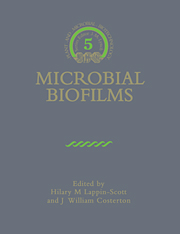Book contents
- Frontmatter
- Contents
- List of Contributors
- Series Preface
- Introduction to Microbial Biofilms
- Part I Structure, Physiology and Ecology of Biofilms
- Part II Biofilms and Inert Surfaces
- Part III Biofilms on the Surfaces of Living Cells
- 12 The Rhizosphere as a Biofilm
- 13 Biofilms of the Ruminant Digestive Tract
- 14 The Immune Response to Bacterial Biofilms
- 15 Bacterial Biofilms in the Biliary System
- 16 Biofilm Associated Urinary Tract Infections
- 17 The Role of the Urogenital Flora in Probiotics
- 18 Dental Plaque
- Index
18 - Dental Plaque
Published online by Cambridge University Press: 24 November 2009
- Frontmatter
- Contents
- List of Contributors
- Series Preface
- Introduction to Microbial Biofilms
- Part I Structure, Physiology and Ecology of Biofilms
- Part II Biofilms and Inert Surfaces
- Part III Biofilms on the Surfaces of Living Cells
- 12 The Rhizosphere as a Biofilm
- 13 Biofilms of the Ruminant Digestive Tract
- 14 The Immune Response to Bacterial Biofilms
- 15 Bacterial Biofilms in the Biliary System
- 16 Biofilm Associated Urinary Tract Infections
- 17 The Role of the Urogenital Flora in Probiotics
- 18 Dental Plaque
- Index
Summary
Introduction
Dental plaque was probably the first biofilm to have been studied in terms of either its microbial composition or its sensitivity to antimicrobial agents. In the seventeenth century, Anton van Leeuwenhoek pioneered the approach of studying biofilms by direct microscopic observation when he reported on the diversity and high numbers of ‘animalcules’ present in scrapings taken from around human teeth. He also conducted early studies on biocides when he established the resistance of these ‘sticky animalcules’ to salt and vinegar.
Following these pioneering observations and until the 1960s, there were relatively few studies of the microbiology of dental plaque. In the past three decades, however, there has been an enormous expansion of knowledge of the biochemistry and bacteriology of the plaque microflora. Impetus for this expansion stemmed from the exploitation of gnotobiotic animal technology in the 1950s and 1960s which established the role of particular bacterial species in the aetiology of two of the commonest diseases to affect humans in industrialised societies, namely, dental caries and periodontal (gum) diseases. The aim of this chapter will be to review our current knowledge of the microbiology of dental plaque, with particular emphasis on properties that relate to its biofilm structure.
Definition of dental plaque
The mouth is unique in the human body in that it provides non-shedding surfaces (teeth) for microbial colonization. Because of this, large masses of bacteria (and their products) are able to accumulate, especially at stagnant sites between teeth (approximal surfaces), in the pits and fissures on occlusal surfaces of premolars and molars, and in the gingival crevice (Fig. 18.1). In contrast, elsewhere in the body, desquamation ensures that the bacterial load is light on mucosal surfaces.
- Type
- Chapter
- Information
- Microbial Biofilms , pp. 282 - 300Publisher: Cambridge University PressPrint publication year: 1995
- 18
- Cited by



